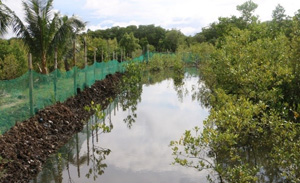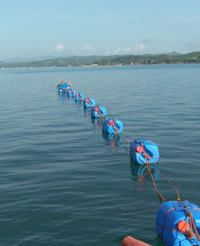 The Philippines has been a major source of Mangrove crab (Alimango) and Green mussel (Tahong) worldwide. It has been hailed as the 2nd top producer of Alimango, and a major producer of Tahong. But the country still has to persevere to rise to the top.
The Philippines has been a major source of Mangrove crab (Alimango) and Green mussel (Tahong) worldwide. It has been hailed as the 2nd top producer of Alimango, and a major producer of Tahong. But the country still has to persevere to rise to the top.
Research and development efforts on these commodities towards achieving more fruitful farming options will help advance the country’s economy and sustain food security because mangrove crab is a prized commodity and mussel is a cheap source of protein.
To address this, the Philippine Council for Agriculture, Aquatic and Natural Resources Research and Development of the Department of Science and Technology (DOST-PCAARRD) funded the projects, “Mangrove crab (Scylla serrata) production in Alabat Island, Quezon Province using an aquasilviculture system” and “Refinement of mussel transplantation techniques for developing mussel farming industry in Quezon.” The projects will be implemented by the Alabat and Tagkawayan campuses of Southern Luzon State University (SLSU).
The projects are being led by Ms. Delia R. Babilonia of SLSU-Alabat and Dr. Victoria M. Noble of SLSU-Tagkawayan, respectively.
Alabat, being surrounded by mangroves, makes it suitable for alimango farming. The site in Tagkawayan, on the other hand, has waters bordered by the towns of San Narciso and Libmanan, Quezon. The site is also facing away from the open waters of the Sibuyan Sea, which makes it ideal for mussel farming.
 Both projects will pilot-test environment-friendly and sustainable farming approaches.
Both projects will pilot-test environment-friendly and sustainable farming approaches.
For alimango farming, a mangrove-friendly aquasilviculture system has been used as a management strategy. The strategy promotes the integration and harmonization of aquaculture with mangrove protection. The farms with the mangrove areas are enclosed with nets, thus preventing the cutting of mangroves and protecting the environment at the same time.
For mussel farming, a long line culture approach, which was recently developed by the University of the Philippines in the Visayas (UPV) through the funding support of DOST-PCAARRD, has been used. This modified farming technique was adopted from New Zealand to suit Philippine setting. It uses a 50-meter main line with one-meter mussel socks hanging for spat enclosure at 50-centimeter intervals. The technique addresses the sedimentation problem brought about by the traditional “stake” method.
The involved communities in the towns of Alabat and Tagkawayan welcome these projects and the municipal mayors actively support their trials. They expect that the introduction of these two new commodities will help in improving the economy of both municipalities.
Once pilot testing, implementation, and adoption of aquasilviculture and long-line culture methods in the province of Quezon is done, a year-round supply of alimango and tahong will be available, and this may open doors for exports. This will also create employment and other opportunities for Alabat and Tagkawayan.
